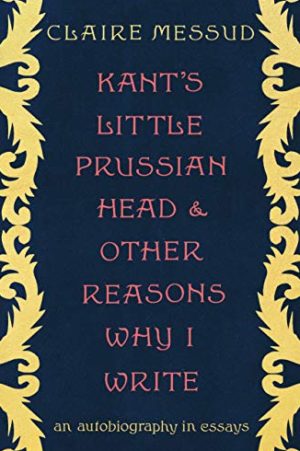Kant’s Little Prussian Head & Other Reasons Why I Write
by Claire Messud
reviewed by Peter Dziedzic
In a year of crisis, many have asked: where can hope be found? In a new collection of essays, Kant’s Little Prussian Head & Other Reasons Why I Write: An Autobiography in Essays, Claire Messud ventures a partial answer, attesting to art and literature’s power as a force for human connection, healing, and discovery—not just in trying times, but in all times.
Part literary memoir and part criticism, Kant’s Little Prussian Head comprises pieces previously published in publications like Vogue, The Paris Review, Granta, and The New York Review of Books. The collection offers a snapshot of Messud’s engagement with “the vast compendium of recorded human experience, from which we draw wisdom, solace, or, at the least, a sense of recognition.” These moments, works, and conversations allow Messud—and, by extension, us—“to slow the hurtling, to calm the chaos, to return to the essentials that make us human.”
Divided into three sections, Kant’s Little Prussian Head consists of Messud’s autobiographical insights, her literature reviews, and some art criticism. The book is, in a way, a palimpsest (one of Messud’s favorite images, which occurs six times in this collection) whose sections explore how life experiences, relationships, and art and literature inform our efforts to connect—to understand and be understood.
“Reflections” focuses mostly on Messud’s family relationships through vignettes of wide-ranging analysis and evocative narration. In “Then,” Messud reflects on her itinerant childhood spent in the United States, Australia, Canada, and France. In reckoning with the constant flux of experience, she takes away a necessary lesson, that:
[The] other life, the hidden one, or ones, is not less real, nor as real, as the life before us. It is infinitely more real, blooming and billowing in the imagination in its fecundity and fullness, colored and enlivened by so many objects, so many sounds and smells, so many minute moments that can never, never be imparted.
Messud finds, in her childhood experiences, an appreciation for the life of the mind. Grappling with the prospect of her father’s death in “The Road to Damascus,” Messud recounts traveling to Beirut to explore the city of her father’s childhood. She shows how these moments have shaped her vocation as a novelist:
I cannot say what drove my father, but what his lessons taught me, I realize belatedly, is to be a novelist. To understand that most of what is you can only imagine, and can imagine only through the often contradictory traces of what you can see. To understand that always, at the heart of things—whatever the ideas and ideologies, the violations and violence, the strangeness of culture—always at the heart are the ordinary people, and there is just life, being lived.
One unexpected and joyful essay is “On Dogs,” in which Messud details what she has learned from her dogs. The essay touches on the question of free will and the necessity of “enjoy[ing] what you have and not lament[ing] what you’ve lost.” The lessons Messud draws from her canine companions—and the lessons imparted in all of these essays—inspire and entertain.
Perhaps the most consequential essay, and the source of the book’s title, is “Kant’s Little Prussian Head and Other Reasons Why I Write.” In this essay, Messud wrestles with Thomas Bernhard’s eponymous metaphor for the futility of writing and the incommunicability of human experience. While Messud admits the challenges of communication, she does not surrender to pessimism, asking, “What is our hope for the experience of literature, if not to share this: shards of memory and new words discovered? What, indeed, if not this, is the best truth of our experience of life?” While there may always be gaps in communication, writers must bridge those gaps, working not for perfect communicability, but to “[f]ail again, fail better.”
The second and third sections, “Criticism: Books,” and “Criticism: Images,” are guided by Messud’s belief in the revelatory power of literature and art—that “[w]e are as much the sum of our lived literary experiences as of our literally lived experiences.” She discusses classics and contemporary works by authors like Albert Camus, Jane Bowles and Valeria Luiselli. While some readers may find Messud’s wide-ranging literary allusion and challenging diction daunting, her intelligent analyses reveal the subtle layers of the texts in question. In her evaluation of Kazuo Ishiguro’s Never Let Me Go, for example, Messud unpacks important lessons about the role of utility and the liberal arts in contemporary society.
The final—and shortest—section of Kant’s Little Prussian Head offers Messud’s art criticism. In essays on Alice Neel, whose images “do with paint and ink what novelists attempt with words: to illuminate the interiority of individuals, to put their souls on paper,” and her favorite pieces at Boston’s Museum of Fine Arts, among other subjects, Messud demonstrates that the same lessons learned from life and literature can also be found in painting. This final section is far shorter than the others, which may leave readers wanting a wider range of art criticism. Although Messud may not have all the answers to our many challenges, she has eloquently and movingly laid bare the ways the arts can remind us of the beauty—and the utter importance—of being human.
Published on March 29, 2021

